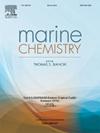TRIS缓冲溶液在人工海水基质中盐度范围5-40,温度范围5-40℃的pHT测量。第1部分:测量和数据拟合
IF 2.5
3区 地球科学
Q2 CHEMISTRY, MULTIDISCIPLINARY
引用次数: 0
摘要
海水总pH值(pHT)的分光光度测量有助于了解海洋碳酸盐系统,从而评估海洋碳循环和监测海洋酸化。分光光度法测量依赖于指示剂染料的第二解离常数的表征,从已知pHT溶液的测量中获得。因此,在等量TRIS缓冲液(即含有等量摩尔数的2-氨基-2-(羟甲基)-1,3-丙二醇(TRIS, CAS参考号77-86-1)和TRIS盐酸(TRIS)缓冲液(TRIS)上进行了Harned细胞电位测量。HCl)),在人工海水(ASW)基质中制成。缓冲溶液在标称实际盐度为5至40的ASW基质中制备,并在5°C至40°C的温度下对这些溶液进行Harned细胞测量。这首次提供了ASW/TRIS缓冲层的pHT值,该值与海洋测量相关的整个盐度范围和广泛的温度范围一致。介绍的工作包括对三个国家计量研究所的结果进行比较,以评估再现性,并提供了一个函数,允许计算等量ASW/TRIS缓冲液pHT作为盐度,温度和TRIS缓冲液摩尔浓度的函数。该函数可用于推导零TRIS质量浓度的pHT值,从而表示纯ASW(即不受TRIS和TRIS存在影响的化学环境)。HCl),并参考真正的pHT刻度。从国际单位制追溯的角度来看,染料的第二解离常数的表征需要这些值。本文章由计算机程序翻译,如有差异,请以英文原文为准。
pHT measurements of TRIS buffer solutions in an artificial seawater matrix in the salinity range 5–40 and temperature range 5–40 °C. Part 1: Measurements and data fitting
Spectrophotometric measurements of seawater total pH () contribute to the knowledge of the oceanic carbonate system, and hence to the assessment of the ocean carbon cycle and the monitoring of ocean acidification. Spectrophotometric measurements rely on the characterization of the indicator dye's second dissociation constant, obtained from measurements on solutions of known . Therefore, Harned cell potentiometric measurements were performed on equimolal TRIS buffers (i.e. buffers containing equal molalities of 2-amino-2-(hydroxymethyl)-1,3-propanediol (TRIS, CAS reference number 77–86-1) and TRIS hydrochloride (TRIS.HCl)), made in an artificial seawater (ASW) matrix. Buffer solutions were prepared in an ASW matrix of nominal practical salinities from 5 to 40, and Harned cell measurements were performed on these solutions at temperatures from 5 °C to 40 °C. This provides, for the first time, values of ASW/TRIS buffers that are consistent for the entire ranges of salinity relevant for oceanographic measurements, and for a wide range of temperature. The work presented includes a comparison of results from three National Metrology Institutes to assess reproducibility, and provides a function allowing the calculation of equimolal ASW/TRIS buffers as a function of salinity, temperature and TRIS buffer molality. This function can be used to derive values for zero TRIS molality, thus representing a pure ASW (i.e. a chemical environment unaffected by the presence of TRIS and TRIS.HCl), and referring to a true scale. These values are needed for the characterization of the second dissociation constant of the dye with perspective of traceability to the International System of units.
求助全文
通过发布文献求助,成功后即可免费获取论文全文。
去求助
来源期刊

Marine Chemistry
化学-海洋学
CiteScore
6.00
自引率
3.30%
发文量
70
审稿时长
4.5 months
期刊介绍:
Marine Chemistry is an international medium for the publication of original studies and occasional reviews in the field of chemistry in the marine environment, with emphasis on the dynamic approach. The journal endeavours to cover all aspects, from chemical processes to theoretical and experimental work, and, by providing a central channel of communication, to speed the flow of information in this relatively new and rapidly expanding discipline.
 求助内容:
求助内容: 应助结果提醒方式:
应助结果提醒方式:


